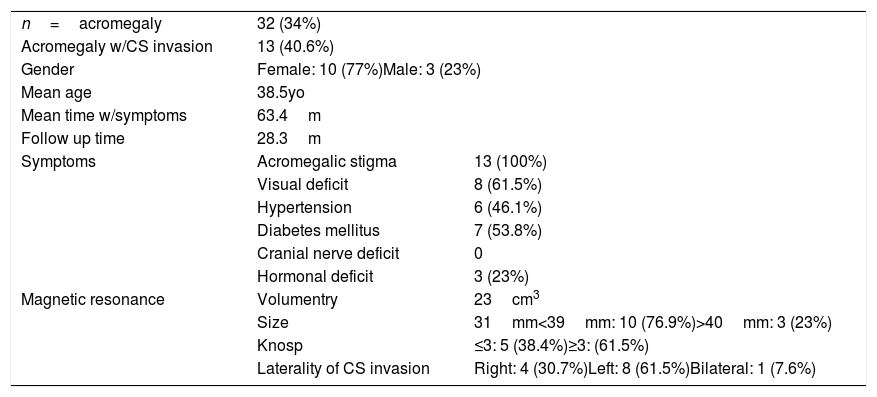Cavernous sinus (CS) invasion is found in 15–20% of pituitary adenomas; it represents a poor prognosis factor and a surgical challenge even in experienced pituitary centers. We present our experience and technical note description for surgical management of pituitary adenomas with CS invasion in acromegaly by the transsellar lateral approach with an endoscopic endonasal transsphenoidal route.
Methodprospective case series of patients who underwent endoscopic endonasal surgery for Growing Hormone (GH) producing adenomas with CS invasion treated at the Neurosurgery departments of National Institute of Neurology and Neurosurgery in Mexico City, and of Toluca Medical Center of Social Security Institute of the State of Mexico and Provinces between January 2014 and March 2019.
ResultsThirty-two of 94 patients with diagnosis of pituitary adenoma treated at our institutions (34%) had acromegaly; thirteen of patients with acromegaly diagnosis met the inclusion criteria for CS invasion. Postoperative images reported gross total resection in 10 patients (76.9%). Mean follow-up time was 28.3 months. Remission criteria were achieved in nine patients (69.2%), with one of these patients (11.1%) having recurrence during follow up. All patients with no biochemical remission had improvement in GH and IGF profiles. Three patients without remission underwent radiosurgery (14Gy), and one patient had remission after the procedure.
ConclusionsWe consider this to be a safe and efficient approach for tumors invading CS, when surgical team have good experience in endoscopy of the skull base and reconstruction techniques, appropriate instruments are available, and tumor has soft consistency.
Se encuentra invasión al seno cavernoso en el 15-20% de los adenomas hipofisiarios, y representa un factor de mal pronóstico, así como un reto quirúrgico en algunas series. En el presente trabajo describimos y evaluamos nuestra experiencia con una técnica quirúrgica para el manejo de adenomas hipofisiarios con invasión al seno cavernoso en pacientes con acromegalia a través de un abordaje transelar lateral por la vía endonasal endoscópica.
MétodosSerie de casos prospectiva de pacientes tratados con cirugía endonasal endoscópica para pacientes con diagnóstico de acromegalia y adenomas hipofisiarios con invasión al seno cavernoso tratados en los Departamentos de Neurocirugía del Instituto Nacional de Neurología y Neurocirugía en la Ciudad de México y en el Centro Médico Toluca del Instituto de Seguridad Social del Estado de México y Municipios entre enero del 2014 y marzo del 2019.
ResultadosTreinta y dos pacientes de 94 con diagnóstico de adenoma hipofisiario fueron tratados en nuestras instituciones, cumplieron con criterios clínicos y bioquímicos para el diagnóstico de acromegalia (34%); de estos, 13 pacientes cumplieron con criterios por imagen y quirúrgicos de invasión al seno cavernoso (40,6%). Las imágenes postoperatorias mostraron resección completa en 10 pacientes (76,9%). El tiempo medio de seguimiento fue de 28,3 meses. Se alcanzó un índice de remisión bioquímica en el 69,2% de los casos, con un paciente presentando recurrencia durante el seguimiento. Tres de los pacientes sin remisión bioquímica fueron sometidos a radiocirugía, con respuesta terapéutica en uno de ellos.
ConclusionesConsideramos que el procedimiento descrito en el presente trabajo puede considerarse una vía segura y eficiente para el abordaje quirúrgico de pacientes con adenoma hipofisiario e invasión al seno cavernoso, cuando el equipo quirúrgico cuenta con experiencia en cirugía de base de cráneo por vía endoscópica, se cuenta con el instrumental adecuado y el tumor es de consistencia aspirable.
Article

If it is the first time you have accessed you can obtain your credentials by contacting Elsevier Spain in suscripciones@elsevier.com or by calling our Customer Service at902 88 87 40 if you are calling from Spain or at +34 932 418 800 (from 9 to 18h., GMT + 1) if you are calling outside of Spain.
If you already have your login data, please click here .
If you have forgotten your password you can you can recover it by clicking here and selecting the option ¿I have forgotten my password¿.













